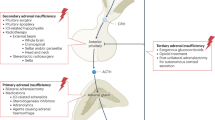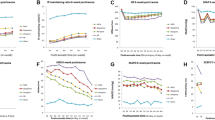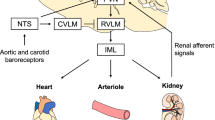Abstract
Study design:
Case report.
Objective:
To describe two clinical examples of denervation hypersensitivity, an enhanced response to catecholamines demonstrated experimentally in tetraplegic patients.
Setting:
USA.
Case reports:
A 63-year-old man with chronic paralysis at C4 ASIA Impairment Scale (AIS) A with partial preservation to T6, and a history of coronary artery and pulmonary disease, developed bradycardia leading to cardiac arrest. He was treated with intravenous atropine 0.4 mg and adrenaline 1 mg. He regained consciousness and blood pressure within 30 s, but developed supraventricular tachycardia leading to ventricular fibrillation and death within minutes. The dose of adrenaline was routine for a cardiac arrest.
A 60-year-old man with chronic paralysis at C6, AIS A, presented with fever to 106 °F and a renal stone. Thirty minutes after treatment with intravenous fluids, antibiotics, and 1 g aspirin orally, he became afebrile, then suddenly lost consciousness and palpable pulse. He recovered with equal rapidity after an intravenous injection of 0.1 mg adrenaline. The dose of adrenaline was a tenth the usual dose for cardiac arrest.
Conclusion:
Because of denervation hypersensitivity, effective treatment of a cardiac arrest in tetraplegic patients may require a reduced dose of adrenaline.
Similar content being viewed by others
Introduction
Severe injury to the cervical spinal cord disables much of the sympathetic nervous system, causing low levels of circulating catecholamines.1 Such a lesion in the sympathetic nervous system also induces denervation hypersensitivity. Experimentally, an infusion of catecholamines into the tetraplegic patient raises blood pressure considerably more than does a comparable dose in the neurologically intact.2 In the practice of spinal cord medicine, denervation hypersensitivity may manifest dramatically when adrenaline is infused as an emergency treatment. Two such cases are described.
Case 1. Failed resuscitation
A 64-year-old man, paralyzed for 18 years at C4 ASIA Impairment Scale (AIS) A with Zone of Partial Preservation to T6, was hospitalized because of chest pain. Past history included a recent episode of headache and a blood pressure of 210/90 in the presence of renal stones. Treatment with nitroglycerin had dropped the blood pressure to 90/62 in 10 min. There was also a history of pneumonia and an episode of heart block with tracheal suctioning. He was a former smoker.
The electrocardiogram revealed normal sinus rhythm, Q waves in Leads III, and AVF, ST elevation in V1-3, depression in V4-6 and the left ventricular hypertrophy by voltage. The tracing, however, was unchanged from that of a year before. A chest film revealed an infiltrate in the left lower lung field.
Chest pain was controlled with morphine sulfate and nitroglycerin in an intensive care unit. Subsequent vital signs were temperature 98.4 °F, pulse rate 80 min−1, respiratory rate 26 min−1, blood pressure 148/54 mm Hg. Minutes later the patient asked to sit up, the pulse rate dropped to 24, then became impalpable and the patient collapsed. Atropine 0.4 mg was administered intravenously immediately followed by adrenaline 1.0 mg. The patient responded with a supraventricular tachycardia of 156 beats per minute that deteriorated to ventricular tachycardia and ventricular fibrillation. The patient expired 3 min after the injection of medication and could not be resuscitated.
Comment
The patient had sustained cardiac and pulmonary disease. The initial cardiac arrest seemed to result from progressive heart block, which the patient had experienced previously. Heart block due to unopposed vagal activity in tetraplegic patients with pulmonary disease has been described.3 The recovery from the first cardiac arrest was attributable to atropine, adrenaline likely to have been unnecessary. However, the conventional dose of adrenaline administered, 1 mg, probably was inappropriately high for a tetraplegic patient and may have led to the second cardiac arrest, a fatal arrhythmia. Experimentally, blood pressure response to adrenaline in a tetraplegic patient is about 10-fold greater than that in the neurologically intact.2 The usual concern in a cardiac arrest is a delay in the administration of adrenaline, whereas an inappropriate dose is a concern in the case of tetraplegia.4
Case 2. Successful resuscitation
A 60-year-old man, paralyzed at C6 AIS A, presented with fever and a history of renal stone. The temperature spiked to 106 °F. He was treated with intravenous fluids and antibiotics and with 1 g of aspirin by mouth. Approximately 30 min later, he was afebrile and sent to the urology suite. He arrived cyanotic and poorly responsive. The pulse was rapid and thready, then absent. The usual dose of adrenaline, 1 mg in a 10 ml solution, was available. Only 1 ml or 0.1 mg was injected by intravenous push. The patient quickly regained pulse, color and consciousness. He recovered from the febrile illness.
Comment
Although sepsis may have been responsible for the cardiovascular collapse, it has been advised that aspirin should not be given for high fever (personal communication, L Weinstein). This presentation incidentally supports that caveat.5
Nevertheless, given an indication for the administration of adrenaline, it is predictable that a low dose of adrenaline will resuscitate a tetraplegic patient. This case demonstrates clinically the denervation hypersensitivity described experimentally in tetraplegic patients.2
Conclusion
Denervation hypersensitivity in the tetraplegic patient can present a hazard to the use of adrenaline in the treatment of cardiac arrest. If anticipated, however, denervation hypersensitivity can be exploited and cardiac arrest can be managed with low-dose adrenaline.
References
Mathias CJ, Christensen NJ, Corbett JL, Frankel HL, Goodwin TJ, Peart WS . Plasma catecholamines, plasma renin activity and plasma aldosterone in tetraplegic man, horizontal and tilted. Clin Sci Mol Med 1975; 49: 291–299.
Mathias CJ, Frankel HL, Christensen NJ, Spalding JMK . Enhanced pressor response to noradrenaline in patients with cervical spinal cord. Brain 1976; 99: 757–770.
Frankel HL, Mathias CJ, Spalding JMK . Mechanisms of reflex cardiac arrest in tetraplegic patients. Lancet 1975; 2: 1183–1185.
Jones PG, Miles JL . Overcoming barriers to in-hospital cardiac arrest documentation. Resuscitation 2008; 76: 369–375.
Schlievert PM, Bettin KM, Watson DW . Effect of antipyretics on group A Streptococcal pyrogenic exotoxin fever production and ability to enhance lethal edotoxin shock. Proc Soc Exp Biol Med 1978; 157: 472–475.
Acknowledgements
This study is the result of work supported with resources and the use of facilities at the Boston Healthcare Center, Boston, MA, USA.
Author information
Authors and Affiliations
Corresponding author
Rights and permissions
About this article
Cite this article
Frisbie, J. Hypersensitivity to administered adrenaline in tetraplegia. Spinal Cord 47, 264–265 (2009). https://doi.org/10.1038/sc.2008.84
Received:
Revised:
Accepted:
Published:
Issue Date:
DOI: https://doi.org/10.1038/sc.2008.84



